- Home
- Chi siamo
- Settore
- Servizi
- Lettura
- Contattaci
Mercato dei prodotti senza glutine: Analisi attuale e previsioni (2024-2032)
Enfasi sul Prodotto (Prodotti da forno, Snack e Prodotti RTE, Pizze e Paste, Dessert e Gelati e Altro); Fonte (Fonti animali e Fonti vegetali); Canale di distribuzione (Minimarket, Supermercati e Ipermercati, Negozi specializzati, Online e Altro); e Regione/Paese
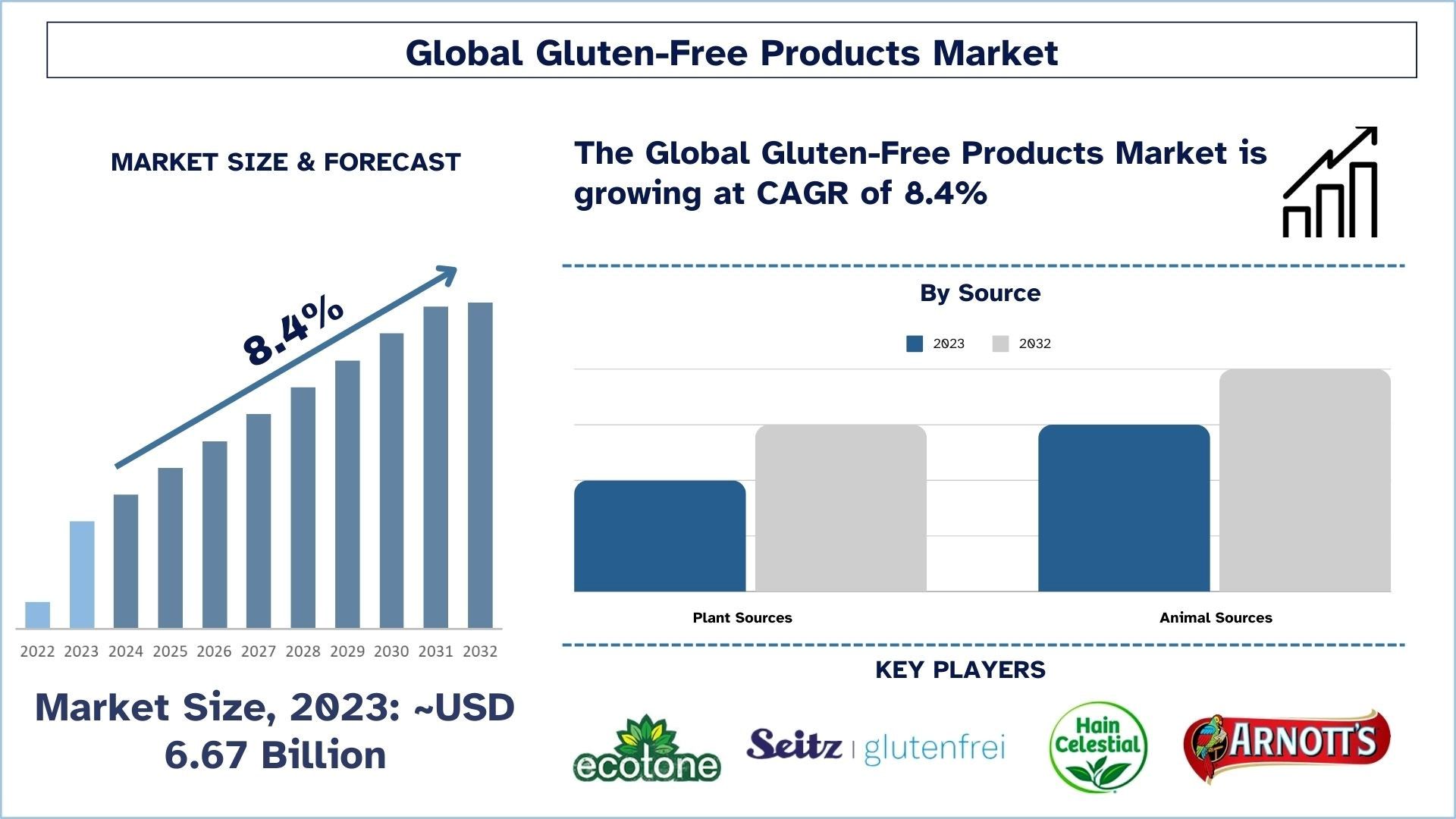
Dimensione e previsioni del mercato globale dei prodotti senza glutine
Il mercato globale dei prodotti senza glutine è stato valutato a 6,67 miliardi di dollari nel 2023 e si prevede che crescerà a un forte CAGR di circa l'8,4% durante il periodo di previsione (2024-2032) a causa della domanda di prodotti senza glutine che sono anche biologici e privi di organismi geneticamente modificati.
Analisi del mercato dei prodotti senza glutine
Il mercato dei prodotti senza glutine è cresciuto a livello globale principalmente perché i consumatori sono resi consapevoli di malattie legate al glutine come la celiachia e la sensibilità al glutine. Anche la richiesta di snack più sani da parte di consumatori consapevoli ha contribuito alla crescita del mercato. Molte aziende hanno aggiunto prodotti senza glutine, dagli alimenti da forno agli snack e alle bevande, grazie agli sviluppi nella tecnologia alimentare e all'innovazione dei prodotti. I fattori strategici che hanno guidato la crescita di questo mercato includono l'aumento dell'uso di prodotti senza glutine per scopi legati allo stile di vita e l'aumento dei canali di disponibilità, tra cui supermercati, presenza online e negozi di prodotti senza glutine. Il Nord America e i paesi europei stanno mostrando maggiormente questa tendenza, ma la regione Asia-Pacifico può essere identificata come un mercato potenziale a causa della crescente popolazione urbana e dell'attenzione ai loro piani alimentari.
Tendenze del mercato globale dei prodotti senza glutine
Questa sezione illustra le principali tendenze del mercato che influenzano i vari segmenti del mercato globale dei prodotti senza glutine, come rilevato dal nostro team di esperti di ricerca.
Il segmento supermercati/ipermercati sta trasformando il settore
Supermercati e ipermercati sono tra i canali di distribuzione più importanti nel mercato dei prodotti senza glutine. Supermercati e ipermercati svolgono un ruolo importante nei mercati offrendo una varietà di prodotti senza glutine. Sezioni, campagne e opzioni di marca e private rendono i canali di vendita al dettaglio cruciali. Essendo alimenti convenienti e negozi unici, garantiscono vendite costanti con prodotti da forno senza glutine freschi.
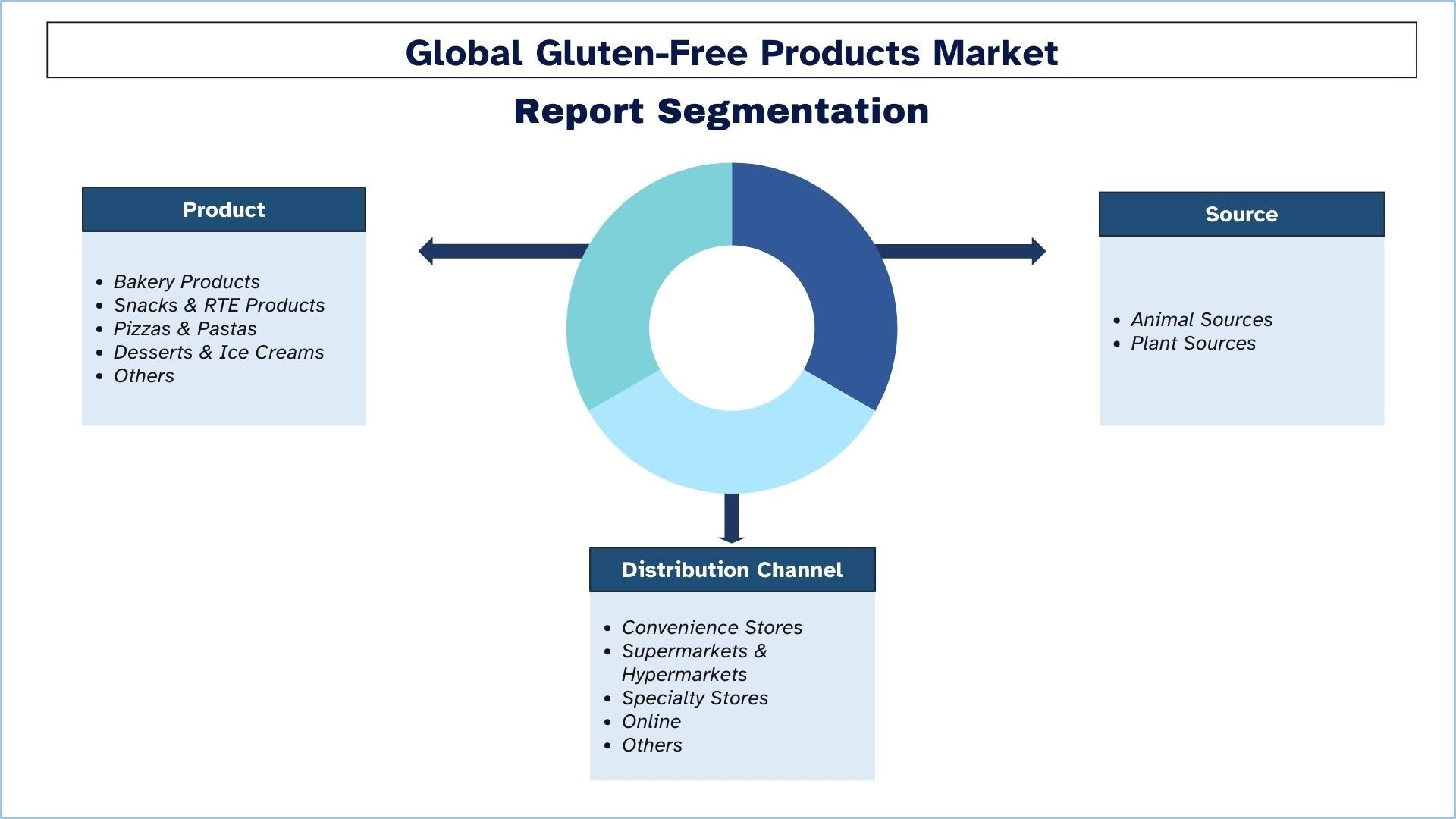
Si prevede che il Nord America crescerà a un ritmo significativo durante il periodo di previsione.
Il mercato nordamericano dei prodotti senza glutine è relativamente nuovo e vivace grazie alla crescente popolarità dei disturbi legati al glutine e dei consumatori attenti alla salute che si rivolgono ai prodotti senza glutine come opzioni più salutari. I soli Stati Uniti rappresentano più di un terzo del consumo, diventando così il più grande mercato mondiale di alimenti senza glutine, la maggior parte dei quali rientra nella categoria dei prodotti da forno, degli snack e dei piatti pronti. I nuovi fattori trainanti includono una migliore fornitura di prodotti, l'introduzione di prodotti alimentari senza glutine di nuova concezione e un'etichettatura di qualità. L'aumento dei negozi online e dei negozi focalizzati esclusivamente sui prodotti senza glutine aumenta anche la domanda nel mercato, non solo per i malati.
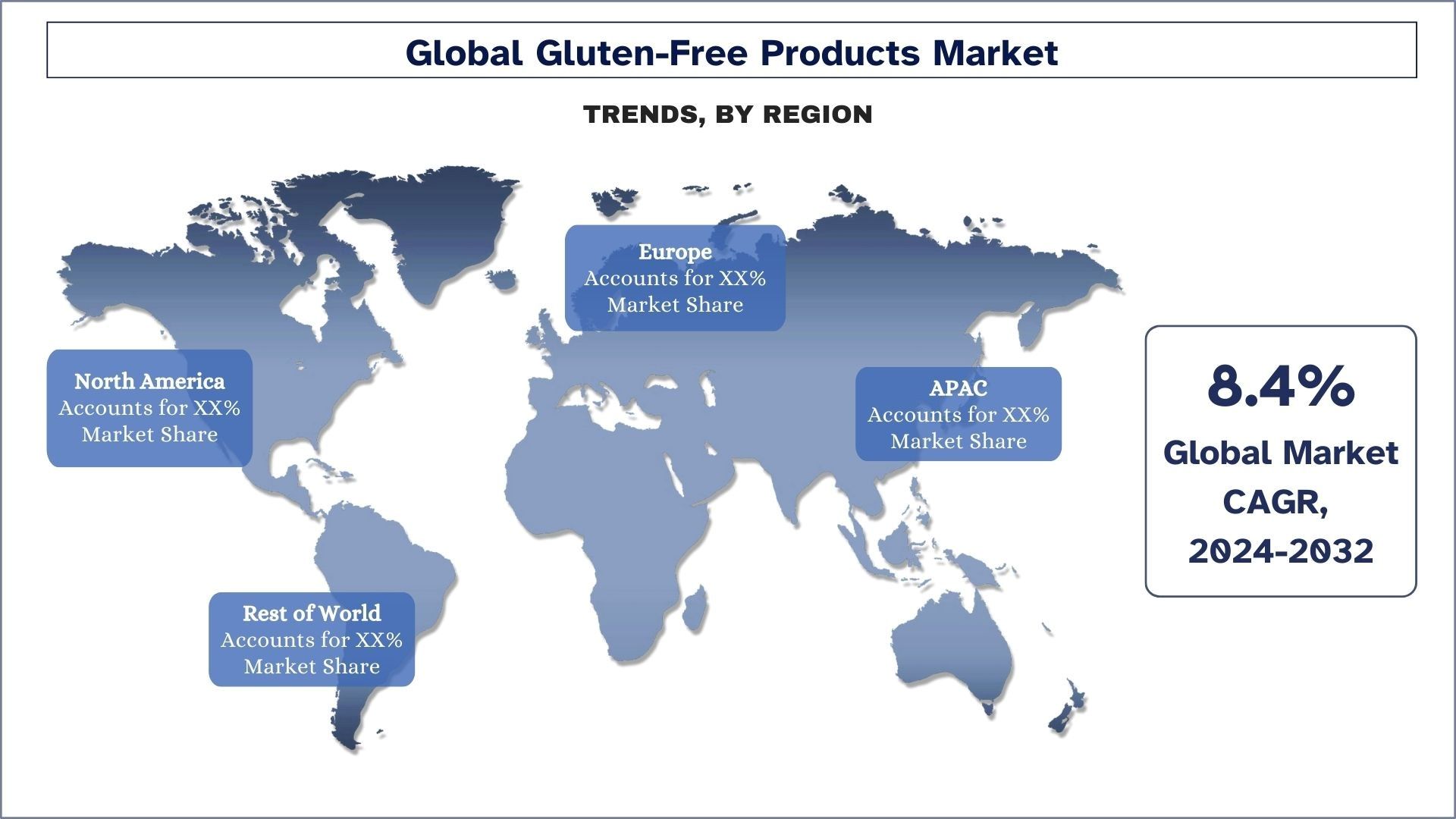
Panoramica del settore globale dei prodotti senza glutine
Il mercato globale dei prodotti senza glutine è competitivo, con diversi attori di mercato globali e internazionali. I principali attori stanno adottando diverse strategie di crescita per migliorare la loro presenza sul mercato, come partnership, accordi, collaborazioni, lancio di nuovi prodotti, espansioni geografiche e fusioni e acquisizioni. Alcuni dei principali attori del mercato sono The Hain Celestial Group; General Mills, Inc.; Kellanova; The Kraft Heinz Company; Barilla G. e R. F.lli S.p.A.; Spaichinger Nudelmacher (ALB-GOLD Group); Arnott’s Group (Kohlberg Kravis Roberts & Co. L.P.); Ecotone; Alara Wholefoods Ltd; PepsiCo, Inc.
Copertura del report sul mercato globale dei prodotti senza glutine
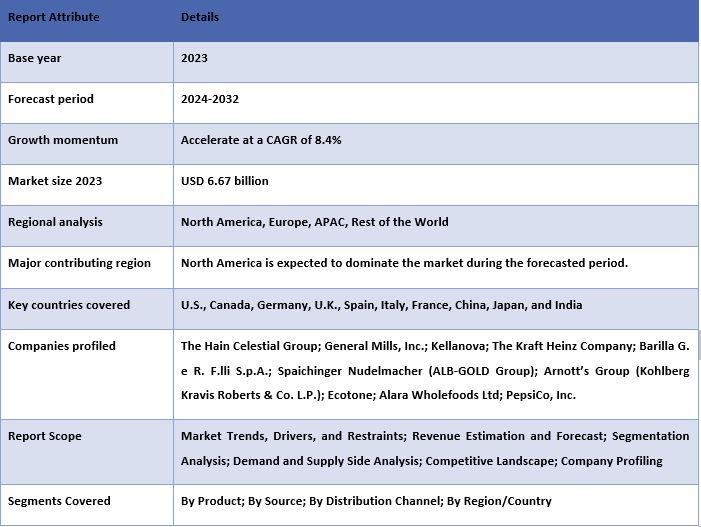
Motivi per acquistare questo report:
Lo studio include l'analisi delle dimensioni del mercato e delle previsioni confermata da esperti chiave del settore autenticati.
Il report riassume brevemente la performance complessiva del settore a colpo d'occhio.
Il report copre un'analisi approfondita dei principali competitor del settore, concentrandosi principalmente sulle principali informazioni finanziarie aziendali, sui portafogli di tipi, sulle strategie di espansione e sugli sviluppi recenti.
Esame dettagliato dei fattori trainanti, delle restrizioni, delle tendenze chiave e delle opportunità prevalenti nel settore.
Lo studio copre in modo completo il mercato attraverso diversi segmenti.
Analisi approfondita a livello regionale del settore.
Opzioni di personalizzazione:
Il mercato globale dei prodotti senza glutine può essere ulteriormente personalizzato in base alle esigenze o a qualsiasi altro segmento di mercato. Oltre a questo, UMI comprende che potresti avere le tue esigenze aziendali, quindi sentiti libero di contattarci per ottenere un report che si adatti completamente alle tue esigenze.
Indice
Metodologia di Ricerca per l'Analisi del Mercato Globale dei Prodotti Senza Glutine (2024-2032)
L'analisi del mercato storico, la stima del mercato attuale e la previsione del mercato futuro del mercato globale dei Prodotti Senza Glutine sono stati i tre passaggi principali intrapresi per creare e analizzare l'adozione globale dei Prodotti Senza Glutine nelle principali regioni. È stata condotta un'esaustiva ricerca secondaria per raccogliere i dati storici del mercato e stimare le dimensioni attuali del mercato. In secondo luogo, per confermare queste intuizioni, sono state prese in considerazione numerose scoperte e ipotesi. Inoltre, sono state condotte interviste primarie esaustive con esperti del settore lungo tutta la catena del valore del mercato globale dei Prodotti Senza Glutine. Per l'assunzione e la convalida dei dati di mercato attraverso interviste primarie, abbiamo impiegato un approccio top-down/bottom-up per prevedere le dimensioni complete del mercato. Successivamente, sono stati adottati metodi di suddivisione del mercato e di triangolazione dei dati per stimare e analizzare le dimensioni del mercato dei segmenti e dei sottosegmenti del settore. Il metodo dettagliato è spiegato di seguito:
Analisi delle Dimensioni Storiche del Mercato
Passaggio 1: Studio Approfondito delle Fonti Secondarie:
È stato condotto uno studio secondario dettagliato per ottenere le dimensioni storiche del mercato globale dei Prodotti Senza Glutine attraverso fonti interne aziendali come relazioni annuali e bilanci, presentazioni sulle prestazioni, comunicati stampa, ecc., e fonti esterne tra cui riviste, notizie e articoli, pubblicazioni governative, pubblicazioni dei concorrenti, report di settore, database di terze parti e altre pubblicazioni credibili.
Passaggio 2: Segmentazione del Mercato:
Dopo aver ottenuto le dimensioni storiche del mercato globale dei Prodotti Senza Glutine, abbiamo condotto un'analisi secondaria dettagliata per raccogliere informazioni storiche sul mercato e condividere diversi segmenti e sottosegmenti per le principali regioni. I principali segmenti inclusi nel report sono prodotto, fonte, canale di distribuzione e regioni. Inoltre, è stata condotta un'analisi a livello di paese per valutare l'adozione complessiva dei modelli di test in quella regione.
Passaggio 3: Analisi dei Fattori:
Dopo aver acquistato le dimensioni storiche del mercato di diversi segmenti e sottosegmenti, abbiamo condotto una analisi dei fattori dettagliata per stimare le dimensioni attuali del mercato globale dei prodotti senza glutine. Inoltre, abbiamo condotto un'analisi dei fattori utilizzando variabili dipendenti e indipendenti come prodotto, fonte, canale di distribuzione e regioni del mercato globale dei Prodotti Senza Glutine. È stata condotta un'analisi approfondita degli scenari di domanda e offerta considerando le principali partnership, fusioni e acquisizioni, espansione aziendale e lanci di prodotti nel mercato globale dei Prodotti Senza Glutine.
Stima e Previsione delle Dimensioni Attuali del Mercato
Dimensionamento Attuale del Mercato: Sulla base delle informazioni utili ricavate dai 3 passaggi precedenti, siamo giunti alle dimensioni attuali del mercato, ai principali attori del mercato globale dei Prodotti Senza Glutine e alle quote di mercato dei segmenti. Tutte le quote percentuali richieste e le suddivisioni del mercato sono state decise utilizzando l'approccio secondario sopra menzionato e sono state verificate tramite interviste primarie.
Stima e Previsione: Per la stima e la previsione del mercato, sono stati assegnati pesi a diversi fattori, tra cui driver e tendenze, vincoli e opportunità disponibili per le parti interessate. Dopo aver analizzato questi fattori, sono state applicate tecniche di previsione pertinenti, ovvero l'approccio top-down/bottom-up, per arrivare alla previsione di mercato per il 2032 per diversi segmenti e sottosegmenti nei principali mercati a livello globale. Il metodo di ricerca adottato per stimare le dimensioni del mercato comprende:
Le dimensioni del mercato del settore, in termini di entrate (USD) e il tasso di adozione del mercato globale dei Prodotti Senza Glutine nei principali mercati a livello nazionale
Tutte le quote percentuali, le suddivisioni e le ripartizioni dei segmenti e sottosegmenti di mercato
I principali attori del mercato globale dei Prodotti Senza Glutine in termini di tipi offerti. Inoltre, le strategie di crescita adottate da questi attori per competere nel mercato in rapida crescita.
Convalida delle Dimensioni e delle Quote di Mercato
Ricerca Primaria: Sono state condotte interviste approfondite con i Key Opinion Leaders (KOL) tra cui dirigenti di alto livello (CXO/VP, responsabile vendite, responsabile marketing, responsabile operativo, responsabile regionale, responsabile nazionale, ecc.) nelle principali regioni. I risultati della ricerca primaria sono stati quindi riassunti ed è stata eseguita un'analisi statistica per dimostrare l'ipotesi dichiarata. Gli input della ricerca primaria sono stati combinati con i risultati secondari, trasformando così le informazioni in informazioni utili.
Ripartizione dei Partecipanti Primari nelle Diverse Regioni
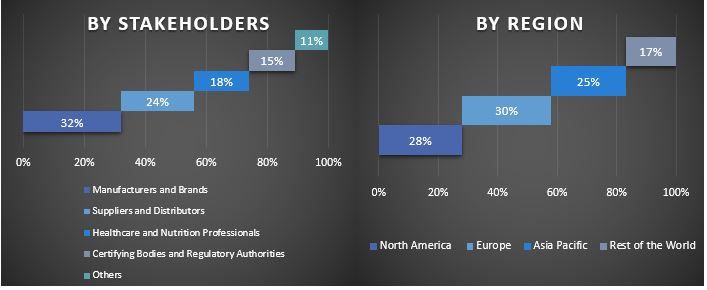
Ingegneria del Mercato
La tecnica di triangolazione dei dati è stata impiegata per completare la stima complessiva del mercato e per arrivare a dati statistici precisi per ciascun segmento e sottosegmento del mercato globale dei Prodotti Senza Glutine. I dati sono stati suddivisi in diversi segmenti e sottosegmenti dopo aver studiato vari parametri e tendenze nel prodotto, nella fonte, nel canale di distribuzione e nelle regioni del mercato globale dei Prodotti Senza Glutine.
L'Obiettivo Principale dello Studio sul Mercato Globale dei Prodotti Senza Glutine
Le tendenze attuali e future del mercato globale dei Prodotti Senza Glutine sono state individuate nello studio. Gli investitori possono ottenere informazioni strategiche per basare la propria discrezione per gli investimenti sull'analisi qualitativa e quantitativa eseguita nello studio. Le tendenze di mercato attuali e future hanno determinato l'attrattiva complessiva del mercato a livello regionale, fornendo una piattaforma al partecipante industriale per sfruttare il mercato non sfruttato per ricevere aiuto da un vantaggio di first-mover. Altri obiettivi quantitativi degli studi includono:
Analizzare le previsioni attuali e le dimensioni del mercato globale dei Prodotti Senza Glutine in termini di valore (USD). Inoltre, analizzare le previsioni attuali e le dimensioni del mercato di diversi segmenti e sottosegmenti.
I segmenti nello studio includono aree di prodotto, fonte, canale di distribuzione e regioni.
Definire e analizzare il quadro normativo per l'industria.
Analizzare la catena del valore coinvolta con la presenza di vari intermediari, insieme all'analisi dei comportamenti dei clienti e dei concorrenti del settore.
Analizzare le dimensioni attuali e previste del mercato globale dei Prodotti Senza Glutine per le principali regioni.
I principali paesi delle regioni studiati nel report includono Asia Pacifico, Europa, Nord America e il Resto del Mondo
Profili aziendali del mercato globale dei Prodotti Senza Glutine e le strategie di crescita che gli attori adottano per sostenere il mercato in rapida crescita.
Analisi approfondita a livello regionale del settore
Domande frequenti FAQ
D1: Qual è la dimensione attuale del mercato globale dei prodotti senza glutine e il suo potenziale di crescita?
Il mercato globale dei prodotti senza glutine è stato valutato a 6,67 miliardi di dollari USA nel 2023 e si prevede che crescerà a un CAGR dell'8,4% durante il periodo di previsione (2024-2032).
Q2: Quali sono i fattori trainanti per la crescita del mercato globale dei prodotti senza glutine?
Crescente consapevolezza da parte dei consumatori delle problematiche di salute legate al glutine, come la celiachia e la sensibilità al glutine.
Q3: Quale segmento detiene la quota di mercato globale più ampia dei prodotti senza glutine per categoria di prodotto?
La categoria dei prodotti da forno detiene la quota maggiore del mercato globale dei prodotti senza glutine per segmento di prodotto.
Q4: Quali sono le tecnologie emergenti e le tendenze nel mercato globale dei prodotti senza glutine?
Sovrapposizione crescente tra diete senza glutine e a base vegetale
Q5: Quali regioni dominano il mercato globale dei prodotti senza glutine?
Si prevede che il Nord America dominerà il mercato durante il periodo di previsione.
Correlati Report
I clienti che hanno acquistato questo articolo hanno acquistato anche










